Dudley, Worcestershire
[Up to 1834]
[After 1834]
[Staff]
[Inmates]
[Records]
[Bibliography]
[Links]
Dudley had a parish workhouse on the south side of Tower Street to the north of the town centre. In 1777, a parliamentary report recorded that it could accommodate up to 100 inmates.
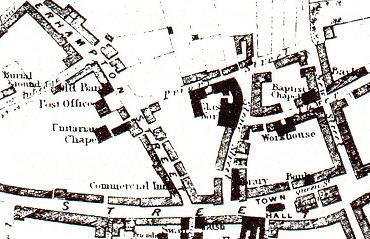
Dudley old workhouse location.
In the same 1777 report, parish workhouses were in operation at Rowley Regis (for up to 60 inmates), Sedgley (60), and Tipton (30).
Sedgley's workhouse is thought to date from around 1734. It was located at the west end of what is now Vicar Street. After its closure in 1859, the workhouse contents were sold off and on July 16th, 1859, the site was sold at auction to Thomas Waterhouse of Bilston, Clerk to the Magistrates. The premises were subsequently converted for use as a police station, still in operation.
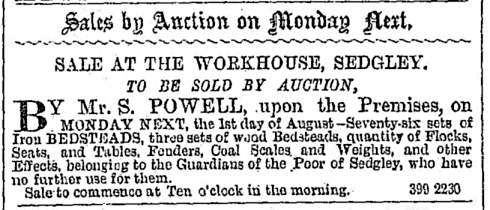
Sedgley sale ad, July 1859.
Tipton appears to have had two workhouses. One, located at Toll End, was in use from around 1755 to the 1790s. The other stood eastern corner of junction of Workhouse Lane, now Alexandra Road, and Lower Church Lane. It was demolished in 1912.
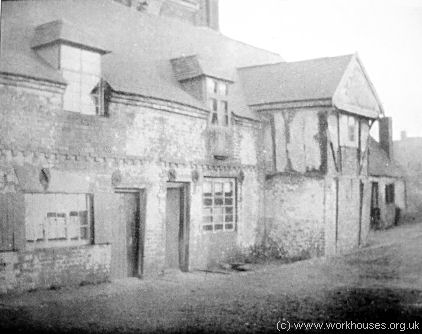
Tipton's Church Lane workhouse, c.1912.
© Peter Higginbotham.
After 1834
Dudley Poor Law Union was formed on 14th October 1836. Its operation was overseen by an elected Board of Guardians, 27 in number, representing its 4 constituent parishes as listed below (figures in brackets indicate numbers of Guardians if more than one):
Worcestershire:
Dudley (10).
Staffordshire: Rowley Regis (3), Sedgley (8), Tipton (6).
The population falling within the Union at the 1831 census had been 66,009 with parishes ranging in size from Rowley Regis (population 7,438) to Dudley itself (23,043). The average annual poor-rate expenditure for the period 1834-36 had been pound;11,455.
Initially, the existing workhouses at Dudley, Sedgley and Tipton (near the junction of Workhouse Lane, now Alexandra Road, and Church Lane) were retained by the union.
In 1842, the Commissioners investigating the employment and conditions of children in mines and manufactories, discovered that workhouse boys, some as young as eight, were being sent on "apprenticeships" of up to twelve years working in coal mines. As a result, some unions in the coal-mining districts of South Staffordshire and adjacent areas were asked to provide detailed information on the children who had been apprenticed in the mining industry in recent years. The return for the Dudley Union covering the years 1840-42 is included below.
| Name of Child | Age | Name of mine. | Term. | Premium. |
|---|
| James Conaway | 9 | Netherton | 21 | Two suits of clothes |
| Richard Hampton | 12 | Wolverhampton | — | Suit of clothes |
| James Southall | 9 | Dudley | — | Ditto |
| William Penn | 12 | Wolverhampton | — | Ditto |
| Joseph Turner | 9 | Dudley | — | Ditto |
| Joseph Holmes | 9 | Tipton | — | Ditto |
| James Cash | 9 | Rowley Regis | — | Ditto |
| Andrew Bridge | 13 | West Bromwich | — | Ditto |
| William Faulkner | 12 | Dudley | — | Ditto |
| John Woodall | 14 | West Bromwich | — | Ditto |
| Thomas Scammell | 9 | Bilston | — | Ditto |
| William Berry | 10 | Ditto | — | Ditto |
In February 1854, it was reported that a man with a wooden leg had recently died in the Sedgley workhouse. Inside the leg, the sum of £1.7s.6d was found secreted.
A new workhouse for 842 inmates was built in 1855-56 to the north of the town at Shavers Hill. The architect was GB Nicholls of West Bromwich. The site layout is shown on the 1883 map below.
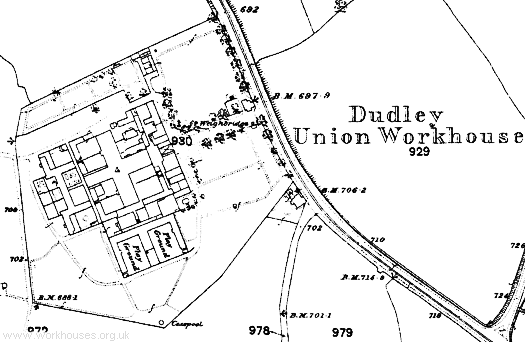
Dudley workhouse site, 1883.
A row of single-storey buildings lay at the east of the site with a central entrance archway. The main building followed the popular cruciform layout with wings for the different classes of inmate (male/female, infirm/able-bodied) radiating from a central supervisory hub. An infirmary lay at the west of the site and a separate block for children at the south.
In 1859, a 113-year-old woman named Sarah Wilton Hughes died at the workhouse after a short period of residence there. During this time, although completely blind, she was said to have knitted stockings for all the other inmates who numbered nearly 200.
On Saturday, 28th April, 1866, the Dudley Guardian published a "Pen-and-Ink Sketch" of the Dudley workhouse, extracts from which are included below.
The new and spacious buildings which constitute the union workhouse of Dudley are pleasantly situate on the turnpike road leading from this town to Wolverhampton. The house, which is calculated to hold 757 inmates, exclusive of the vagrant wards, which accommodate 20 of each sex, was erected in 1859, at a cost of about 18,600l. The entire building consists of detached quadrangular blocks, one-half, that on the left of the centre as one enters, being exclusively devoted to the females, and the other, that lying to the right, being set apart for the males. The first thing that strikes the visitor is the absolutely perfect cleanliness of the entire house. Nothing bordering in the slightest degree upon dirt or dust is tolerated throughout the whole series of the rooms. Everything is punctiliously neat and tidy, and the very stone stairs leading from corridor to corridor are as faultlessly white as human hands can make them. Leaving the master's office, we enter a comparatively spacious room, originally intended to be the Board-room, for the weekly meetings of the Guardians, and furnished with a suitable ante-chamber in which the paupers could remain till their applications had been decided by the Board. Over opposite there is a nice room for the clerk's office, but now used as a kind of store. It was found impracticable to hold the meetings of the Board at this place, owing to the great extent of the union, and to the fact that Dudley is more central, and therefore more convenient for the members attending the weekly meetings. On the left of this place there is a receiving room for females, and they are accommodated with a bed and bath before they see the doctor. The visitor is next introduced to the female tramp ward, and this room will, no doubt, be closely examined by strangers. The place is, however, an honourable exception to the miserable sheds which are found attached to other workhouses. The, writer examined it very closely, and found it comfortable and warm, and at the same time well ventilated, and rigidly clean, so that even the most fastidious "dandy" might have no misgivings in entering. The arrangements for "casuals" are as follows: The ward is rectangular, and along the wall opposite the door there runs a wooden platform about a foot or 18 inches high in front, and sloping upwards for a distance of about eight feet, at an incline of six or eight inches. On this the beds, which are made of straw, are ranged in order, the heads being at the top. Each casual has a bed, and a separate blanket and quilt, and there is no confusion or promiscuous huddling together, as in other localities. If the tramps come in before seven o'clock, they first of all are served with supper, consisting of bread and cheese, or bread and butter and tea, if they are footsore and exhausted; they then retire to rest, and turn out about six o'clock next morning, and are asked who will stay to work. Those who remain to pick a pound of oakum get a breakfast of five ounces of bread and half-a-pint of oatmeal gruel. If any of them complain of being ill the doctor is sent to them. Refractory persons are set in a room apart from others, to pick oakum; and this is looked upon as a punishment. As a rule, however, the women are very tractable, and undress themselves properly, but the men will not attempt to do so unless compelled. The heat of the tramp ward is amply provided for by a concealed stove running alone the entire room, and under the platform on which the beds are extended. One of the pauper inmates has charge of this department. The description given of this ward, and indeed of all the wards on this side of the house, applies equally to the corresponding male wards on the right side. Coming along the ground floor still, the visitor is ushered into the female infirm ward, in which 18 old women are accommodated. These creatures seem quite happy and cheerful, and in common with all the other female inmates, are under the watchful care of the matron. The beds are tastefully neat, and well arranged, and a comfortable fire at the remote end of the room diffuses a genial heat through the spacious apartment. Immediately overhead there is another room for women of the same class, and here there is a poor imbecile who spends her day from morning till night knitting. Over this room there is a similar ward for the same class of aged and infirm. On the same corridor there are four rooms appropriated to married couples of 60 years of age, but at present two only are occupied. In the old women's day ward, on the ground floor, several aged creatures may be seen sitting down at tables, and engaged in knitting, and making themselves otherwise useful. Here may be perceived a once wealthy and independent lady, the wife of an ironmaster in this district, seated in the midst of her companions in poverty, and to all appearances oblivious of the old old times when she had vassals to bow to her will. If moralising were requisite or desirable, here might be found a suitable theme. A special ward is appropriated to young childless women; and from this we pass into the nursery ward, which, at first intimation, might be supposed to be the noisiest in the house. Such is not always the case, however, and the children are quietly attended to, ordinarily speaking. Pretty little iron swing cribs are provided for the younglings, and in these they are rocked gently to sleep. They are nursed by their mothers solely, and such of the latter at work out of the room have access to the children at all times. Passing by the laundry, drying, and washing-rooms, we come to the boys' and girls' dining room, where about 120 of both sexes take their meals, entering and retiring at opposite sides of the hall. There is also a ward for infants who have left the nursery ward at three years of age, and these little things are under the care of a responsible inmate. Like the elder juveniles, they have a spacious yard to disport in, fenced in with palisades. They attend school at certain portions of the day. The girls' school next claims attention. It is at present presided over by Miss Herbert, who has been lately appointed. About 60 children are now on the rolls, and they receive instruction in the usual elementary branches, reading, writing, arithmetic, geography, &c. The hours are from 9 to 12, and from 2 to 4. When the girls are old enough they are sent out to service. The writing of the elder girls is really admirable, and would shame the calligraphy of many a boarding school miss. A lavatory and also a play-room for wet weather are contiguous to the school. Over the school is the dormitory, well ventilated, and rigidly cleansed. The boys' school is in the same building, and is conducted by Mr. John Barclay, whose labours have been highly successful during the short time he has hold office. Some of the boys, of whom there are 40 now in attendance, and from the ages of 6 to 12 or 13 years, are tolerably versed in the rudiments already specified. They appear cheerful and industrious, and, indeed, intelligent likewise. Their dormitory is over the school, and they are provided with day-room and play-yard.
Over the boys' rooms is a spacious ward for extremely old women, and this is shut off from all communication with the remainder of the building. One of the old women in this room is aged 88, and retains all her faculties in perfection. A fine view is to be had from the windows. There are now 31 aged creatures in the ward, the available space being divided into three compartments at the suggestion of the master. The next block of houses which claim attention are the infirmary buildings. These comprise a female idiot ward, with 28 inmates, a regular Babel of noises and incoherent talk; a female bad-leg ward, general sick wards, infectious disease ward (separate from the main block), male sick wards, male idiot ward, male bad-leg ward, asthmatical and bronchital ward, and a surgery. The sick wards contain at present 90 males and 89 females, and this number is below the weekly average. This calculation does not include the idiots. From the cooking kitchen which is furnished with Jeakes's (London) steam-cooking machines, we pass on to the general dining-room. In this fine hall are dined all the able-bodied adults, who are summoned by a bell to their three meals, order being preserved by the porter. On Sundays and Thursdays Divine service is held in this room, and each morning prayers are said at half-past six, the matron being always present. All the inmates, except Roman Catholics, attend Divine service, and the latter are permitted to go to Dudley. A harmonium is provided for worship, and the entire church service is chanted in the usual manner. The next room which the visitor may enter is that in which the oakum is picked. Here the labour is conducted in its several stages by about 30 men daily. There is a series of excellent store rooms for keeping all the necessary articles of consumption, and those are arranged in a most orderly manner. In the stone yards upwards of 20 men are engaged every day in breaking stones. When not at this kind of labour they are to be found working over the grounds and gardens. The condition of the front grounds at the present time is most creditable indeed , In 1859, when the house was opened, the front piece of ground was covered with brick-kilns or broken-up in clay-pits, while the land at the rear was only a series of pit mounts. Thanks to the active exertions of the master, all this is changed, and the walks are now arranged in excellent style, a spacious carriage drive leading from the porter's lodge beside the turnpike road up to the front of the building, A weighing Machine is placed over opposite the lodge, and all articles coming in are weighed. Such is a brief sketch of the present condition of the Dudley union workhouse; and the greatest credit is reflected not only upon the obliging master, Mr. Thomas W. Stillard, but also upon Mrs. Stillard, the matron, for the admirable care and unceasing solicitude with which they continue to conduct the entire house.
In July 1874, a 19-year-old servant named Mary Ann Tyler was charged with the murder of her baby which had been born in the workhouse in May. Tyler left the workhouse on June 1st and the following day, the body of the child was found in the canal. The child was identified by a workhouse nurse, Eliza Jones. Tyler was found guilty of manslaughter.
The buildings were added to at various times, including the Rosemary Ednam Maternity and Nurses Home in 1926.
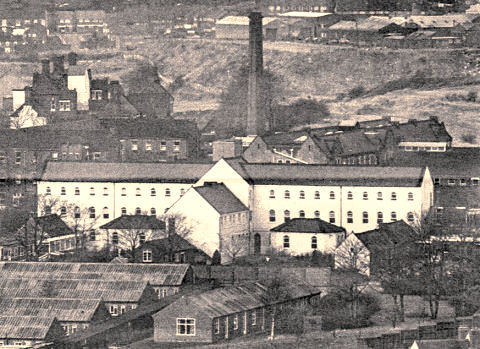
Dudley workhouse from the south-east
Courtesy of Ian Beach.
The workhouse later became Burton House Public Assistance Institution, then Burton Road Hospital (now closed). The former workhouse buildings have now been completely demolished. The picture of the entrance below was taken in 1989 by the late Harold Beach who was a member of a voluntary group called Friends of Burton Road Hospital.
Cottage Homes
The Dudley Union established children's cottage homes at: Ashleigh, Hurst Hill, Bilston; Woodcross House, Woodcross Street, Cinder Hill, Bilston; and
Dibdale Road, Dudley. They could house a total of 90 children. There was also a Central Home at Longnor House, 93 Queen's Cross, Dudley.
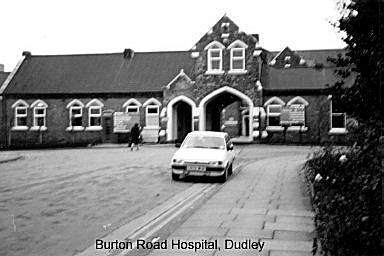
Dudley workhouse entrance, c.1989.
Courtesy of Ian Beach.
Records
Note: many repositories impose a closure period of up to 100 years for records identifying individuals. Before travelling a long distance, always check that the records you want to consult will be available.
-
Dudley Archives and Local History Service, Tipton Road, Dudley, DY1 4SQ.
Holdings include: Guardians' minute books (1836-1923); Admissions and discharges (1839-1929, with gaps); Creed registers (1868-1933, with gaps); etc.
[Top of Page]
[Unions List]
[Unions Map]
[Home Page]








